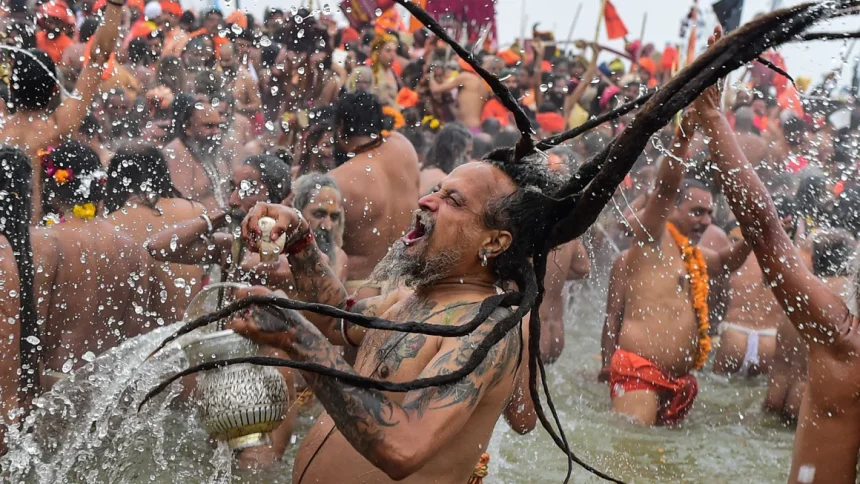Hundreds of millions of Hindu devotees have bathed in sacred waters, despite concerns over overcrowding and water pollution, as the world’s largest religious gathering wrapped up Wednesday in India’s northern state of Uttar Pradesh.
Over the last 45 days, more than 620 million people – nearly a third of India’s roughly 1.4 billion population – have attended the Maha Kumbh Mela, or the festival of the Sacred Pitcher, on the riverbanks in the city of Prayagraj, in a spectacle of color and expression of faith.
Followers have come to take a holy dip in the Triveni Sangam, the confluence of three holy rivers – the Ganges, Yamuna and the mythical Saraswati – to purify their sins and take another step closer to “spiritual liberation.”
Every 12 years the festival carries the prefix “Maha,” which means great, as it’s the largest gathering of the Kumbh Mela that’s held every three years in one of four cities.
“It is a unique, once in a lifetime experience,” said Sushovan Sircar, 36, who works as an independent consultant in Delhi. “People from all over India are here, as I saw number plates of cars from almost every state.”

Though this year’s festivities have been marred by two separate, deadly crowd crushes, millions have turned out for the festival despite concerns of overcrowding and reports of “unsafe” levels of contamination in key bathing sites.
A report from the Central Pollution and Control Board (CPCB), part of India’s Environment Ministry, last month found high levels of coliform faecal bacteria in the Ganges and Yamuna rivers, despite the government touting sustainable initiatives and sanitation efforts.
Uttar Pradesh’s Chief Minister Yogi Adityanath denied the accuracy of the government report, insisting that the water was not just safe for bathing, but also for the Hindu ritual of drinking a handful after bathing.
Attendees often submerge themselves fully, sometimes drinking or collecting the sacred water in containers.
‘My sins are cleansed, but not my body’
Sircar, the independent consultant from Delhi, said he bathed in the water at Sangam point – the confluence of the three rivers considered to be the most auspicious place to bathe and where most people take their dip – twice last week.
“There is a concern because there is nothing I can do about the contamination in the water. In your mind you tell yourself, this part looks clean, spend a few minutes in, recite prayers and come out,” said Sircar.
“I took a shower for sins and then another shower for the contamination,” he laughed. “So you need a bath after the bath… My sins are cleansed, but not (my) body.”

Before the festival began, India’s top environmental court directed the state and federal pollution boards to ensure the river water was clean enough to drink and bathe in. It called for increasing monitoring and sample collecting of the Ganges and Yamuna rivers and ensuring that no untreated sewage or solid waste would be discharged.
But a report submitted by the federal pollution board on February 3 stated that faecal coliform levels, a key indicator of untreated sewage and faecal matter in water, were far above the safe limit set by the board of 2,500 units per 100 millilitres.
At various parts of the Ganges and Yamuna rivers around Prayagraj levels were more than 1,000 over the safe limit, according to the report.
Adityanath said his government was continually monitoring the water levels to ensure its quality.
Kumbh Mela organizers also told CNN that an “exhaustive survey” of all 81 drains that release water in the rivers was carried out ahead of the festival.
“We have ensured that the water quality has been maintained,” said Kumbh Mela officer Vivek Chaturvedi.
Aishwary Sharma, 31, a finance professional in Delhi, said he took a dip in the rivers despite knowing it could be polluted.
“I think it is quite evident that the Ganga and Yamuna are not clean rivers,” he said. “(But) there are many things that are bad for you… The air we breathe is so toxic for our health… It is just another thing that is polluted that could have a harmful impact on my health.”
For others, their faith and participating in the sacred festival was more important than their concerns.
“What (most people) are interested in is their devotion and religion and that they want to take that holy dip,” said Sunny Parasher, 34, from Panchkula in Haryana state.
“Where there is devotion, where there is religion, there is no question,” he said.
Kalpana Mishra, 55, a housewife from Prayagraj, said she would not take another holy dip after reading the pollution board’s report.
“What does being a literate person mean if you hear all this and still decide to go?” she asked.
Exposure to faecal contamination can cause water borne diseases such as typhoid, diarrhoea, cholera, gastroenteritis, E-coli, skin disease and vomiting, health experts warn.
Push to clean the rivers

Indian Prime Minister Narendra Modi has made cleaning the Ganges, India’s holiest river, a priority since first taking office in 2014 – with billions of dollars spent or pledged on sewage treatment, cleaning surface waste and afforestation in the decade since.
The Ganges, a lifeline for 400 million people who live and work along it, runs through 50 Indian cities that pump out about 3 billion liters of sewage every day – only a fraction of which is treated before it reaches the river, according to the World Bank.
The Yamuna, a tributary of the Ganges, has also for decades been plagued by the dumping of toxic chemicals and untreated sewage.
Ahead of the festival, Indian authorities touted this year’s gathering as a “Green Kumbh,” with sustainable initiatives such as a ban on single-use plastics, eco-friendly toilets, electric rickshaws and an army of 15,000 sanitation workers hired to clean up after major bathing days.
The Ministry of Culture said in January that the festival had been “meticulously planned to uphold hygiene and ecological balance” and would “set an example for future large-scale events worldwide” in environmental responsibility.
Protecting and cleaning the river was even a major theme at a conference held on the sidelines of the festival with religious and environmental leaders coming together for the first time on how religious institutions can address the climate crisis.
“If there is no water in the rivers, there is no Kumbh. We don’t consider it water, we consider it nectar,” said Indian spiritual leader Swami Chidanand Saraswati at the meeting. “If we all do not make efforts to protect it, then the next (Kumbh Mela) will be on mere sand.”
But complicating the green efforts was the enormous crowd size at this year’s Kumbh Mela, which saw 250 million more people than originally expected, according to one expert. Authorities had planned for about 400 million people to attend over the six-week gathering, with about 9 million people per day, but about 620 million people attended in total, according to government figures.
“It is a mammoth task to take care of such a crowd,” said Dr Nupur Bahadur, an associate director with The Energy and Resources Institute (TERI), a research institute that looks at wastewater management, established by the Indian government.
River contamination could be better managed by adopting better on-site prevention and disinfection methods, Bahadur said.
One of them could be halting the dip after every 12 hours for one hour” and letting fresh water run through the bathing areas before “the dips can be restarted,” she said.
Bahadur said that while the festival’s “massive increase in footfall” strained its infrastructure, it has still been “the best human effort possible” in such a situation.
Prayagraj resident Mishra said she will be happy when her city gets back to normal.
“My eyes are constantly burning and there is so much dust,” she said. “I want the festival to end so I can get back to my life.”










